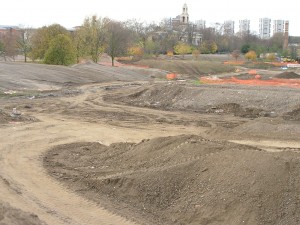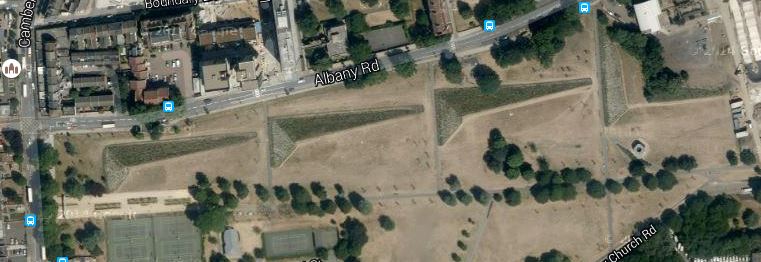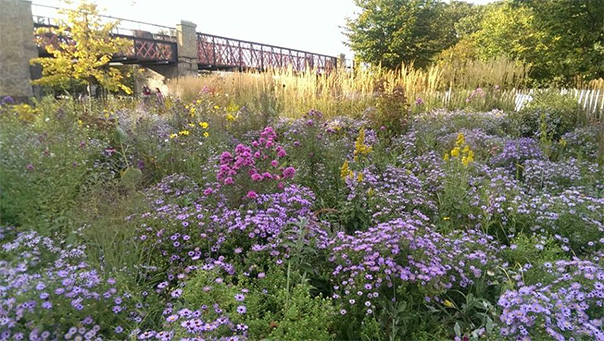Burgess Park has some of the most beautiful piles of rubble this time of year!
Come and find out about them on a guided walk with the designer, James Hitchmough, on 8th August 2015, starting at 11am. Read on for details and links.
At the hand-over of Burgess Park from the GLC (at their dissolution in 1986) to Southwark Council, there were many buildings remaining in the park. In some cases, the GLC had plans for them, which were never realised due to their demise. In other cases, compulsory purchase had not been arranged yet, or there were long leases about to expire.
These buildings were nearly all eventually cleared by Southwark Council in the following ten years. In many cases, the rubble was simply piled up and topsoil dumped on top of it all. So various hillocks appeared wherever the buildings had happened to be.
At the revitalisation stage in 2010, it was decided to make a feature of these hills by re-arranging them into a more meaningful formations.

The previous low plateaued hillocks became higher and steeper with ‘faces’ providing different climatic conditions to accommodate various kinds of planting.
The designers, LDA, engaged the services of the Sheffield University Horticultural Department to plan the planting. James Hitchmough, celebrated for the London 2012 Olympic gardens, wildflower meadows and horticultural planting, devised meadow and prairie-like elements, and these were sown in January 2012.

The north slopes comprise a ground layer of sown, shade-tolerant, mainly woodland perennials from which emerge summer and autumn flowering tall perennials. The West facing slopes support a heat and drought tolerant cosmopolitan meadow, running down to a drainage swale at the base. Despite some of the challenges, public response to the wildflowers has been extremely positive.
Professor Hitchmough will lead a walk explaining the design and planting, and describe how he arrived at the design. The walk will start at the western end, at the Tennis Courts near Addington Square, and visit the hills nearby. It will then move on to St Georges Gardens at the eastern side of the park, where he designed complex garden-like planting, which is looking beautiful now.
Please sign up for the walk on Eventbrite, where there will be a small deposit to pay, refundable on the day.


Beautiful planting.
Is there a list of plants used? Particularly the Asters?
Dear all
In reply to the question about the plants at St Georges, especially the names of the different asters:
The prairies at St Georges Way, designed by the famous Mr Hitchmough, are a wonderful mix of North American species found growing wild in the mesic and dry prairies of the USA, an additional mix of mainly European species in the shadier areas, plus a small selection of other wild flowers (ox eye daisy, false chamomile). There are also poor attempts by the well meaning but misguided head gardener to fill in a few gaps with Pheasants Tail grass from the Mediterranean (Amenthale lessonia). These we will move in Spring to the mounds since it clearly doesn’t fit with the rest of the planting, though would have looked ok aesthetically… and finally a few experiments with Echium’s pininana and candicans that also don’t fit with the planting since they are from the Canary Isles but would look so nice in flower that we may plant as dot plants in barer sections.
Firstly the asters have done very well in the cooler weather this summer. Last year most of them were a little frazzled in the summer heat.
Unfortunately many members of the aster family have been reclassified into new genus’ including all the ones on the lists.
So Aster azureus (taller pale blue one) has now been renamed as the much more easy to spell ‘Symphyotrichum oolentangiense’
https://www.missouribotanicalgarden.org/PlantFinder/PlantFinderDetails.aspx?kempercode=d209
… the amazing white aster was Aster divaricartus but now called ‘Eurybia divaricata‘
https://www.missouribotanicalgarden.org/PlantFinder/PlantFinderDetails.aspx?kempercode=h170
Finally the genus of A. Oblongifolius (shorter pale blue one) and A. novae-angliae ‘ September ruby’ (crimson) have also changed to Symphyotrichum .
https://www.missouribotanicalgarden.org/PlantFinder/PlantFinderDetails.aspx?kempercode=j490
https://www.rhs.org.uk/Plants/354033/i-Symphyotrichum-novae-angliae-i-Font-Face-times-New-Roman-September-Ruby-FONT/Details?returnurl=%2fplants%2fsearch-results%3fnm%3dAster%2bnovae-angliae%26aliaspath%3d%252fplants%252fsearch-results
The latter is the one that draws the eye most but either they are creating variable coloured offspring with variable shaped flower or there are other cultivars than September Ruby also present, as the colours vary from deep crimson to purpley pink and even some salmon-y pink ones.
Hopefully I am correct with the above info, I’d like to say I knew this all by heart but can only truly confirm that I’ve finally noticed there is a second y in Symphyotrichum.
As for the rest of the plants, it is a bewildering selection, and I’m still trying to work them all out myself… I’ll type the list up in a separate comment. If people have further questions about the other plants at St Georges or elsewhere please let me know, and I will do my best to answer in an at least vaguely accurate manner.
Cheers,
Gregory Smith
Full list of specified plants at St Georges. I can’t confirm if this is exactly the plants used in the end, but have found most things on the list are present in varying quantities. I’ve reclassified the asters in the previous comment, and some other species in this list may also have had their names changed in the last decade. I think my favourite are the bright scarlet starry flowers of Silene regia, or ‘Royal Catchfly’.
Short Prairie
Asclepias tuberosa
Symphyotrichum oblongifolium
Callirhoe bushii
Carex testacea
Dianthus carthusianorum
Echinacea pallida
Echinacea paradoxa
Echinacea purpurea
Erygium yuccifolium
Galium verum
Galtonia candicans
Kniphofia triangularis
Liatris aspera
Linum narborense
Oenothera macrocarpa var incana
Oenothera tetragona
Origanum vulgare
Penstemon barbatus
Rudbeckia fulgida var dreamii
Scutellaria baicalensis
Silene regia
Silphium terebinthinaceum
Veronica incana
Eremurus stenophylla
Pulsatilla vulgaris
Schizachyrium scoparium
Sedum ‘ Red Cauli’
Taller prairie
Symphotrichum oolentangiense
Eurybia divaricata
Symphyotrichum novae-angliae ‘ September Ruby’
Symphyotrichum oblongifolium
Coreopsis tripteris
Echinacea pallida
Echinacea purpurea
Erygium yuccifolium
Gillenia trifoliata
Penstemon barbatus
Penstemon digitalis ‘Husker’s Red’
Rudbeckia fulgida var dreamii
Silene regia
Silphium laciniatum
Silphium terebinthinaceum
Solidago speciosa
Tradescantia ohioensis
Cimicifuga simplex
Eupatorium maculatum ‘Riesenchirm’
Lobelia tupa
Panicum virgatum ‘ Shenandoah’
Rudbeckia maxima
Veronicastratum virginicum ‘ Lavanderturm’
Woodland shade mix
Ajuga reptans ‘Jungle Beauty’
Aruncus diocus ‘ Kneiffii’
Epimedium ‘Frohnleiten’
Epimedium x rubrum
Euphorbia amygdaloides ‘Rubra’
Galium oderatum
Helleborus foetidus
Helloborus x hybridus ‘ Ashwood Strain’
Liriope muscari
Omphalodes cappadocicum
Polystichum setiferum ‘ Herrenhausen’
Eranthis hiemalis
Narcissus pseudonarcissus
Scilla sibirica ‘ Spring Beauty’
Bupthalmum salicifolium
Heuchera villosa
Lathyrus vernus
Primula elatior
Primula veris
Hedges
Pittosporum tobira
Crataegus monogyna
Fagus sylvatica
Acer campestre
Carpinus betulis
Blocks of grasses
Pennisetum alopecuroides
Calamagrostis acutiflora
Best wishes, G. Smith
Thank you so much good sir for the plant list!
thank you so much for sharing the planting list!